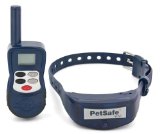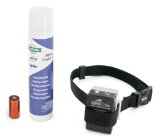Table of Contents
Overview | How the Collars Work | When to Avoid Using | Vet Q & A
Summary:
"Stop barking dog collars can be an effective way to train your dog when not to bark. Several choices of anti-barking devices are available including types that use a small electrical shock, smell and sound. All are considered to be effective when used with some type of reward."
Overview
Stop barking dog collars work by triggering some type of negative reward so that your dog associates it with barking. The collars work via a sensor that detects that bark which then activates the collar. There are basically three types of collars:
- Electric: These collars are battery operated. They are activated via a remote control. The collars are designed to deliver a safe, but unpleasant little static charge (PetSafe Comfort-Fit Bark Control Collar) or vibration as a way of training the dog not to bark. Differences between collars include the strength of the unpleasant experience, size and battery type.
and/or a vibration to encourage dogs not to bark
- Smell or Odorless Anti Bark Collars: These collars work by releasing a citronella or lemon spray as a deterrent. Studies demonstrate that these types of collars are just as effective as other shown on this page. Collars such as the Multivet Odorless Spray Collar accept cartridges which are odorless or have an odor. Odorless collars can be equally effective.
- Sound Device (not a collar): These anti bark devices use a short ultrasonic tone when the dog barks that only your dog can hear, then re-set themselves when the barking stops. Devices such as the PetSafe Stationary Bark Control sit in the room where the barking occurs and are not collars. These devices have a 25 foot range from where you place the device.
and emits a tone that people can't hear to deter barking
Research among owners shows that owners are somewhere between 80% and 97% satisfied with the way the collars and anti-bark devices work.
Stop Barking Dog Collar - How They Work
Barking can be perceived as a positive and rewarding behavior by your dog. If you react to the barking that could be seen by your dog as a positive reaction thereby reinforcing the behavior.
Collars are somewhat controversial since they use a form of punishment to change behavior. This is different than behavior modification where a positive behavior such as sitting and receiving a treat is substituted for the negative. Even with this concern, collars are proven to be safe and studies show that they do not increase the anxiety of your dog.
It is suggested that you should reinforce the behavior with something positive such as a treat or some form of affection such as calling them to sit. If you don't your dog may grow accustomed to the punishment and start ignoring it.
You should not have the collar on your dog all of the time, but use it occasionally over time. This way your dog will not ignore the "punishment" and by using it when the problem tends to occur their is a higher likelihood of learning.
Do Anti Bark Devises Work?
Research shows that in 97% of cases they do work to some degree with 30% of experiencing a big improvement in their dog's barking behavior.
Studies are somewhat mixed regarding which type of collar works best. All collars seem to work with a preference for collars that use a citronella smell or no smell.
When Should Anti Bark Devices Not Be Used?
You need to understand the cause of barking before using a stop barking dog collar. Use the following guide to understand when not to use an anti barking device:
Territorial Barking: If your dog barks when he or she is protecting a specific area or territory they may only associate the punishment with that area. They may avoid that location and bark in others. Be sure to use the collar in several locations to avoid this problem.
Barking at Strangers: If strangers trigger the barking the dog may associate the collar punishment with the presence of other people and thereby trigger a stronger negative reaction.
Separation Anxiety: Collars should not be used if your dog barks when you leave the house. Other methods for separation anxiety are preferred. One method is to provide your dog with a treat filled Kong Toy prior to leaving the house. Then leave for 30 seconds and return. Repeat and extend the interval. Use more toys for longer stays and provide new ones to keep it interesting. Over time this will desensitize your dog to the separation.
Ask a Question or Share Your Story
Have A Dog Behavior Question or Story?
Do you have a question for our veterinarian about Dog behavior? If yes, we will answer it for free.
We will do our best to get back to you quickly (depends on how many questions we receive each day). If you do require an immediate response we suggest using this online dog veterinary service that is available now.
What Other Visitors Have Said
Click below to see contributions from other visitors to this page...
Stopping Excited Dog Barking in the Car Upon Arrival Not rated yet
How do I stop my dog barking in the car when we arrive at our destination. Dog is super excited!
Editor Suggestion for Stopping Excited Barking in …
References
Bowen J and Heath S.
Behaviour problems in small animals
Elsevier Saunders, London, England
Beaudet, R.
Comparing the effectiveness of citronella with unscented odor



